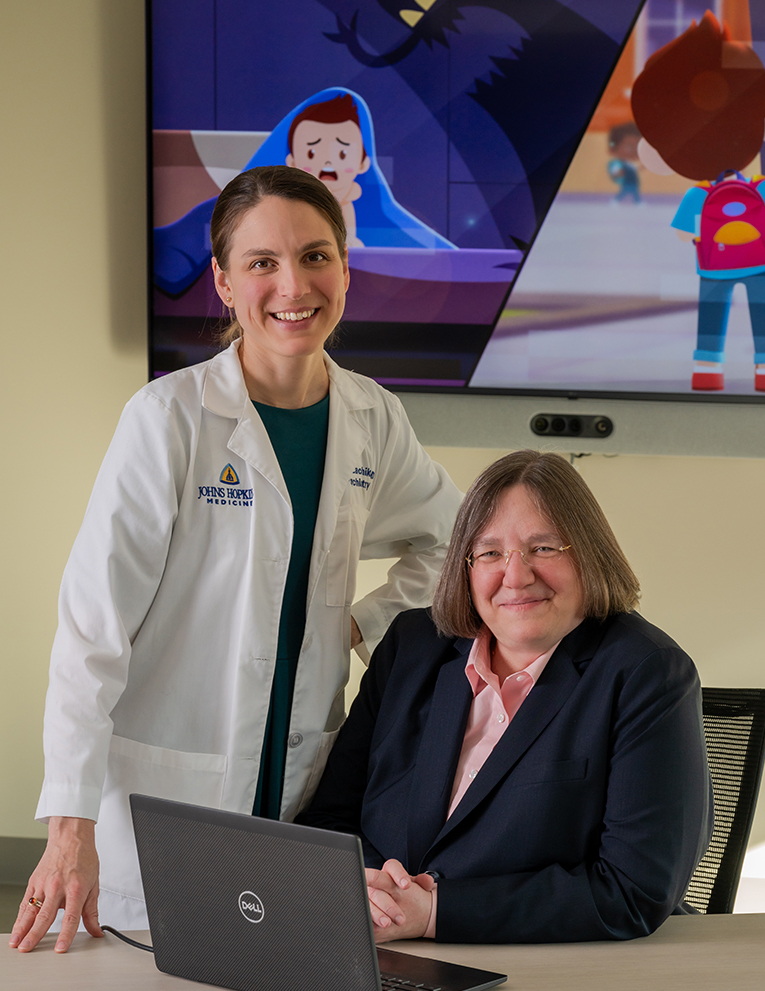Program Will Address Mental Health in Middle Schools
Goal of ADAP Jr. High is to help young people recognize and manage anxiety.

Johns Hopkins psychiatrists Claire Zachik and Karen Swartz
Claire Zachik is often surprised by how little her patients in their early teens know about anxiety.
She will observe them fidgeting, not making eye contact or swallowing their words. But when she asks if they are experiencing anxiety, they say, “What’s that?” says Zachik, a child and adolescent psychiatrist who completed her medical degree and residency at Johns Hopkins before joining the faculty in 2021.
By the time these patients come to her, they’ve been living with symptoms for a while, she notes. “My hope is that young people get access to this information sooner, and through a source that’s a little more reliable than TikTok.”
To achieve that goal, Zachik and fellow Johns Hopkins psychiatrist Karen Swartz are developing a program that will give middle school students tools to recognize and manage anxiety and seek the treatment they deserve.
ADAP Jr. High builds on the Adolescent Depression Awareness Program (ADAP) started in 1999 by Swartz, professor of clinical psychiatry and behavioral sciences and director of clinical and educational programs at the Johns Hopkins Mood Disorders Center.
While ADAP brings education about depression to high schools, ADAP Jr. High will focus on anxiety as well as depression, and will take place in middle schools.
The program is expected to feature nine 15-minute lessons, accompanied by animated videos. As an example, says Zachik, one lesson will likely focus on differences between helpful and unhelpful anxiety. “If you have a test in two days, helpful anxiety might motivate you to study and do really well, and unhelpful anxiety might motivate you to not go to school and not take the test at all,” she says.
Students will also learn developmentally appropriate coping skills, she says, like breathing techniques, planning ahead and talking to an adult.
The program will include online instruction, offered at no cost, for the teachers or counselors who lead the lessons. Zachik says her review has found no other program with the same combination of middle school-based learning about anxiety and free online training for teachers.
“My hope is that young people get access to this information sooner, and through a source that’s a little more reliable than TikTok.”
Claire Zachik
The History of ADAP
Swartz started ADAP after three Baltimore high school students died by suicide in 1998. “We thought about what would be the best long-term contribution,” she says, and decided on depression education. At the time, few understood that depression was a treatable mental illness, she says.
At first, Swartz, along with the late psychiatric nurse Sallie Mink, and psychiatry and behavioral sciences faculty member Todd Cox, traveled to schools and taught students themselves. To scale up the program, Swartz and her colleagues launched a curriculum for high school educators, teaching them about depression and how to lead student discussions. In 2019, they created an online training program for educators.
As of October 2023, ADAP had trained 3,449 instructors, reaching more than 137,734 students in 257 schools in 21 states and Washington, D.C., according to a tally on the website.
Almost from ADAP’s start, says Swartz, middle school parents, teachers and counselors requested a program for younger students. The timing for ADAP Jr. High is good now, she says, partly because “I needed a collaborator who is also a fantastic child psychiatrist, and Claire Zachik is just the person,” and partly because “the pandemic has created a greater crisis, and it feels important to try to do something to help.”
Several funding sources are making it possible, she says, particularly the Buerger Family Foundation and Dalio Philanthropies.
Swartz expects the development and launch of ADAP Jr. High to proceed relatively quickly. “We already know how to train professionals, and how to do it online,” she says. What’s more, she adds, “In 2023, the recognition that this education is critical for young people is much greater. Schools will be more receptive to this curriculum.”
